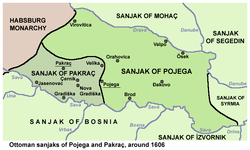Sanjak of Pojega
| Sanjak of Pojega Pojega Sancağı Požeški sandžak | |||||
| Sanjak of the Ottoman Empire | |||||
| |||||
|
Coat of arms | |||||
| Capital | Pojega (Požega) | ||||
| History | |||||
| • | Established | 1538 | |||
| • | Disestablished | 1699 | |||
| Today part of | Croatia | ||||

Part of a series on the |
|---|
| History of Slavonia |
 |
|
Antiquity |
|
Habsburg Monarchy |
|
20th century |
The Sanjak of Pojega (Turkish: Pojega Sancağı; Croatian: Požeški sandžak) was an administrative unit of the Ottoman Empire formed around 1538. It existed until the Treaty of Karlowitz (1699), when the region was transferred to the Habsburg Monarchy. It was located in present-day eastern Croatia, in Slavonia region. The capital of the sanjak was Pojega (Croatian: Požega).
History
The first defter in the sanjak was held in 1540.[1]
The Sanjak of Pojega included territory between Sava and Drava rivers and at first was part of the Rumelia Eyalet. In 1541, it was included into Budin Eyalet, in 1580 into Bosnia Eyalet, in 1596 into Zigetvar Eyalet, and in 1600 into Kanije Eyalet. The Sanjak of Požega was one of six Ottoman sanjaks with most developed shipbuilding (besides sanjaks of Smederevo, Nicopolis, Vidin, Zvornik and Mohač).[2] Toward Croatian and Slavonian border the Ottomans populated numerous Christian Vlachs, who either already lived there or who were brought from the Serb populated Ottoman territories, to live between their border garrisons.[3] Because of the substantial number of Vlachs, parts of the Sanjak of Pakrac and Sanjak of Požega were referred to as Mala Vlaška (English: Little Wallachia).[3]
However, triggered by the last administrative changes, a mutiny started in Pojega in 1611. Mutiners requested that Sanjak of Pojega should be returned to the jurisdiction of the Bosnia Eyalet. Because of the mutiny, the decision from 1600 was changed and Sanjak of Pojega became a condominium shared between Bosnia and Kanije eyalets.[4]
After Ottoman defeat in the Battle of Slankamen (1691), the 1699 Treaty of Karlowitz transferred territory of the sanjak to the Habsburg Monarchy, thus the Sanjak of Pojega no longer existed. The last sanjak-bey of the Sanjak of Pojega was Ibrahim-pasha.[4]
See also
References
- ↑ http://www.ibn-sina.net/bs/component/content/article/1412-posjedi-zvaninika-i-njihovih-porodica.html
- ↑ Godis̆njak grada Beograda. Beogradske novine. 1979. p. 35. Retrieved 7 September 2013.
Ипак градња бродова се посебно везивала за шест санџака: никопољски, видински, смедеревски, зворнички, пожешки и мохачки.
- 1 2 Klaić, Vjekoslav (1974). Povijest Hrvata od najstarijih vremena do svrsetka XIX stoljeća (in Serbo-Croatian). Nakladni zavod Matice hrvatske. p. 4.
Izmedju tih gradova i naokolo njih smjestili su brojne krscanske Vlahe, koji su ili ondje vec prije prebivaU ili su ih iz nutarnjih turskih (srbskih) zemalja onamo dopremili.
- 1 2 Društvo istoričara Bosne i Hercegovine (1952). Godišnjak: Annuaire (in Serbo-Croatian). p. 190. Retrieved 10 March 2013.
Посљедњи пожешки санџак-бег звао се Ибрахим-паша.
